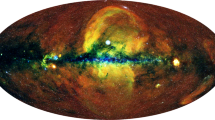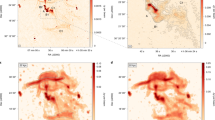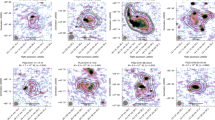Abstract
Most of the baryons in galaxy clusters reside between the galaxies in a hot, tenuous gas1. The densest gas in their centres should cool and accrete onto giant central galaxies at rates of 10–1,000 solar masses per year1. No viable repository for this gas, such as clouds or new stars, has been found1. New X-ray observations, however, have revealed far less cooling below X-ray temperatures than expected2, altering the previously accepted picture of cooling flows. As a result, most of the gas must be heated to and maintained at temperatures above ∼2 keV (ref. 3). The most promising heating mechanism is powerful radio jets emanating from supermassive black holes in the central galaxies of clusters4. Here we report the discovery of giant cavities and shock fronts in a distant (z = 0.22) cluster caused by an interaction between a radio source and the hot gas surrounding it. The energy involved is ∼6 × 1061 erg, the most powerful radio outburst known. This is enough energy to quench a cooling flow for several Gyr, and to provide ∼1/3 keV per particle of heat to the surrounding cluster.
This is a preview of subscription content, access via your institution
Access options
Subscribe to this journal
Receive 51 print issues and online access
$199.00 per year
only $3.90 per issue
Buy this article
- Purchase on Springer Link
- Instant access to full article PDF
Prices may be subject to local taxes which are calculated during checkout




Similar content being viewed by others
References
Fabian, A. C. Cooling flows in clusters of galaxies. Annu. Rev. Astron. Astrophys. 32, 277–318 (1994)
Peterson, J. R. et al. High-resolution X-ray spectroscopic constraints on cooling-flow models for clusters of galaxies. Astrophys. J. 590, 207–224 (2003)
Fabian, A. C., Mushotzky, R. F., Nulsen, P. E. J. & Peterson, J. R. On the soft X-ray spectrum of cooling flows. Mon. Not. R. Astron. Soc. 321, L20–L24 (2001)
McNamara, B. R. et al. Chandra X-Ray Observations of the Hydra A cluster: An interaction between the radio source and the X-ray-emitting gas. Astrophys. J. Lett. 534, 135–138 (2000)
Bîrzan, L. et al. A systematic study of radio-induced X-ray cavities in clusters, groups, and galaxies. Astrophys. J. 607, 800–809 (2004)
Fabian, A. C. et al. A deep Chandra observation of the Perseus cluster: shocks and ripples. Mon. Not. R. Astron. Soc. 344, 43–47 (2003)
Forman, W. et al. Reflections of AGN outbursts in the gaseous atmosphere of M87. Astrophys. J. (in the press)
Soker, N. et al. A moderate cluster cooling flow model. Astrophys. J. 549, 832–839 (2001)
Nulsen, P. E. J. et al. The cluster-scale AGN outburst in Hydra A. Astrophys. J. (submitted)
Scheuer, P. A. G. Models of extragalactic radio sources with a continuous energy supply from a central object. Mon. Not. R. Astron. Soc. 166, 513–528 (1974)
Heinz, S., Reynolds, C. S. & Begelman, M. C. X-ray signatures of evolving radio galaxies. Astrophys. J. 501, 126–136 (1998)
Condon, J. J. et al. The NRAO VLA sky survey. Astron. J. 115, 1693–1716 (1998)
Bicknell, G. V., Dopita, M. A. & O'Dea, C. P. Unification of the radio and optical properties of gigahertz peak spectrum and compact steep-spectrum radio sources. Astrophys. J. 485, 112–124 (1997)
De Young, D. S. On the relation between Fanaroff-Riley types I and II radio galaxies. Astrophys. J. Lett. 405, 13–16 (1993)
Donahue, M., Stocke, J. T. & Gioia, I. M. Distant cooling flows. Astrophys. J. 385, 49–60 (1992)
Churazov, E. et al. Evolution of buoyant bubbles in M87. Astrophys. J. 554, 261–273 (2001)
Churazov, E. et al. Cooling flows as a calorimeter of active galactic nucleus mechanical power. Mon. Not. R. Astron. Soc. 332, 729–734 (2002)
Edge, A. C. The detection of molecular gas in the central galaxies of cooling flow clusters. Mon. Not. R. Astron. Soc. 328, 762–782 (2001)
McNamara, B. R. & O'Connell, R. W. Star formation in cooling flows in clusters of galaxies. Astron. J. 98, 2018–2043 (1989)
Donahue, M. & Stocke, J. T. ROSAT observations of distant clusters of galaxies. Astrophys. J. 449, 554–566 (1995)
Wu, K. K. S., Fabian, A. C. & Nulsen, P. E. J. Non-gravitational heating in the hierarchical formation of X-ray clusters. Mon. Not. R. Astron. Soc. 318, 889–912 (2000)
Markevitch, M. The LX-T relation and temperature function for nearby clusters revisited. Astrophys. J. 504, 27–34 (1998)
Gebhardt, K. et al. A relationship between nuclear black hole mass and galaxy velocity dispersion. Astrophys. J. Lett. 539, 13–16 (2000)
Stocke, J. T. et al. The Einstein Observatory extended medium-sensitivity survey. II—The optical identifications. Astrophys. J. Suppl. 76, 813–874 (1991)
Ferrarese, L. & Merritt, D. A fundamental relation between supermassive black holes and their host galaxies. Astrophys. J. 539, L9–L12 (2000)
Heckman, T. M. et al. Present-day growth of black holes and bulges: the SDSS perspective. Astrophys. J. 613, 109–118 (2004)
Clarke, T. E., Kronberg, P. P. & Böhringer, H. A new radio-X-ray probe of galaxy cluster magnetic fields. Astrophys. J. Lett. 547, 111–114 (2001)
Kronberg, P. P. et al. Magnetic energy of the intergalactic medium from galactic black holes. Astrophys. J. 560, 178–186 (2001)
Furlanetto, S. R. & Loeb, A. Intergalactic magnetic fields from quasar outflows. Astrophys. J. 556, 619–634 (2001)
Acknowledgements
B.R.McN. thanks G. Evrard, D. De Young, M. Sharma and J. Shields for discussions. The National Radio Astronomy Observatory is operated by Associated Universities Inc., under cooperative agreement with the National Science Foundation. This work was supported by a NASA Long Term Space Astrophysics grant, a Chandra Archival Research grant, a Chandra Guest Observer grant, and a contract from the Department of Energy through the Los Alamos National Laboratory.
Author information
Authors and Affiliations
Corresponding author
Ethics declarations
Competing interests
The authors declare that they have no competing financial interests.
Rights and permissions
About this article
Cite this article
McNamara, B., Nulsen, P., Wise, M. et al. The heating of gas in a galaxy cluster by X-ray cavities and large-scale shock fronts. Nature 433, 45–47 (2005). https://doi.org/10.1038/nature03202
Received:
Accepted:
Issue Date:
DOI: https://doi.org/10.1038/nature03202
This article is cited by
-
Particle energization in space plasmas: towards a multi-point, multi-scale plasma observatory
Experimental Astronomy (2022)
-
The formation of dusty cold gas filaments from galaxy cluster simulations
Nature Astronomy (2020)
-
Constraining Gas Motions in the Intra-Cluster Medium
Space Science Reviews (2019)
-
Structures and Components in Galaxy Clusters: Observations and Models
Space Science Reviews (2015)
-
X-ray cavities and temperature jumps in the environment of the strong cool core cluster Abell 2390
Astrophysics and Space Science (2015)
Comments
By submitting a comment you agree to abide by our Terms and Community Guidelines. If you find something abusive or that does not comply with our terms or guidelines please flag it as inappropriate.



